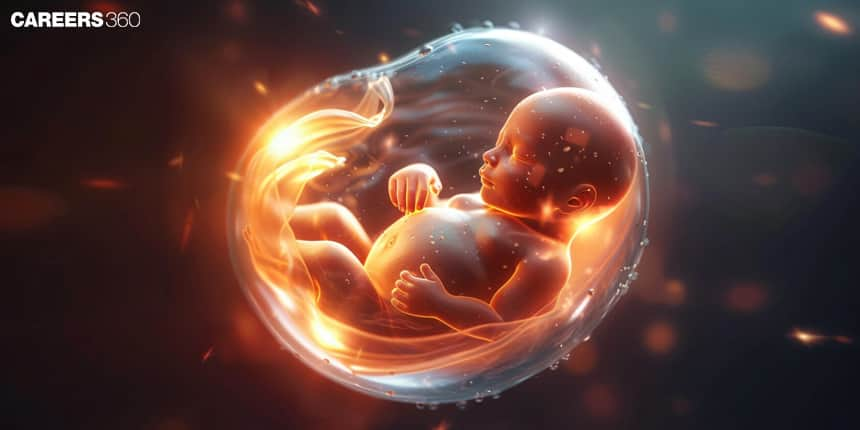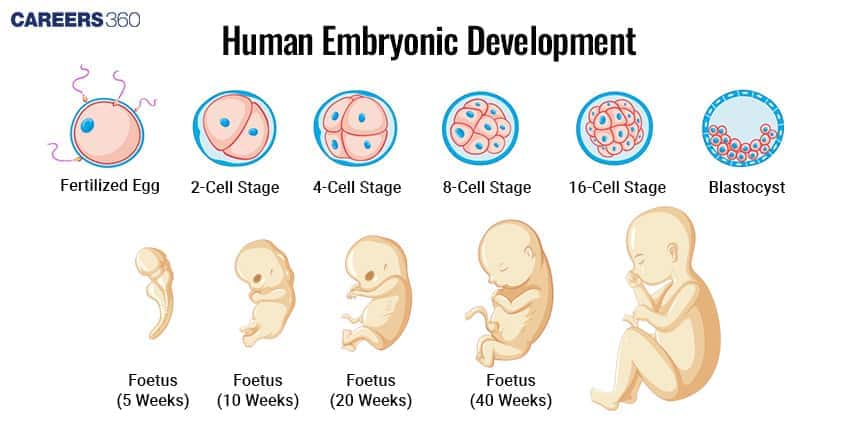Embryo Development: Definition, Stages, Types and Examples
Embryonic development begins with fertilization, followed by others like cleavage, morula, blastocyst, and organogenesis. The embryonic stage in the human embryo development process is characterized by cell differentiation and the development of major structures. It is studied in pregnancy and embryonic development class 12 Biology with the help of embryonic development diagrams, pictures of the embryo, and embryo diagrams. Understanding these different stages of embryo development is important so that the course of how an embryo is formed during pregnancy can be well understood.
NEET 2025: Mock Test Series | Syllabus | High Scoring Topics | PYQs
NEET Important PYQ's Subject wise: Physics | Chemistry | Biology
New: Meet Careers360 B.Tech/NEET Experts in your City | Book your Seat now
- What is an Embryo?
- Embryo Development
- Stages of Embryo Development

What is an Embryo?
The earliest developing stage of multicellular organisms that appears right after fertilization and is before the stages of the fetus is the embryo. It's in this stage that rapid cell divisions and differentiation occur to lay a base for all the necessary structures and systems of the organism.
In human beings, it starts at conception and continues until the end of the eighth week of pregnancy. The beginning period is important in understanding the different stages of embryo development like fertilization, early embryonic stages, gastrulation, neurulation, and organogenesis.
Also Read
Embryo Development
Often, what we refer to as the process by which an embryo is formed starts in fertilization, whereby the sperm fertilizes the egg cell, and the outcome is a zygote. Such a cell contains all the genetic material needed to constitute a fully-fledged organism. In that zygote, very rapid mitotic divisions begin to occur resulting in the forming of a multicellular structure known as the morula.
This is when a morula transforms into a blastocyst, which then implants into the uterine wall. The embryonic development is considered early development when cells begin to differentiate and all the basic structures necessary for continued growth are established. This in itself forms a very important stage in the study of stages of embryonic development, especially when it comes to human embryo development.
Stages of Embryo Development
The development of an embryo includes the following stages:
Fertilization
The first appearance of the fertilised egg is when sperm and egg meet and this is followed by penetration, fusion and finally zygote formation.
Two genetic contributions, one from the mother and one from the father come together to provide the blueprint for the new organism.
Early Embryonic Development:
Cleavage: a zygote becomes a morula, followed by the blastocyst. The latter consists of the inner cell mass.
Implantation, where the blastocyst implants into the uterine wall under the guidance of hormonal preparation in the mother.
Gastrulation
It is at this stage that the three germ layers ectoderm, mesoderm and endoderm form. The layers eventually develop into the tissues and organs in the body.
The importance of this stage is that it helps develop the body plan and initiates the formation of numerous organ systems.
Weeks after Fertilization | Embryonic Development |
Week Three | Formation of three germ layers neural tube and notochord start forming. |
Week Four | Heart starts beating arm buds and eye pits are visible. |
Week Five | Size ~ 4 mm and embryo development becomes C-shaped inner ear and pharyngeal arches form liver, pancreas, spleen, and gall bladder develop. |
Week Six | Size ~ 8 mm. The eyes and nose form and leg buds and hand paddles appear. The stomach and kidneys start developing. |
Week Seven | Size ~ 13 mm. The lungs, lymphatic system, and sex organs start developing, arms and legs grow, and fingers and toes appear. |
Week Eight | Size ~ 20 mm. The external ears, nipples, and hair follicles start developing, most organs are forming. |
Also Read
Frequently Asked Questions (FAQs)
Fertilization, cleavage and blastulation, implantation, gastrulation, neurulation, organogenesis, and fetal development are some of the major steps of embryo development.
Once a sperm has penetrated and fused with an egg cell, the fertilized egg or zygote embarks upon developing embryonically.
The placenta nourishes and oxygenates the embryo development by carrying nutrients, disposing of waste products, and excreting hormones to maintain pregnancy.
Genetic factors are vital for determining the developmental blueprint in building up an organism, guiding the building of tissues and organs, and defining susceptibility to genetic disorders.
More commonplace genetic disorders include Down syndrome, Turner syndrome, and neural tube defects, all of which can be detected earlier than ever before during prenatal development by several methods of prenatal screening, including ultrasound, amniocentesis, and chorionic villi sampling.
Also Read
03 Dec'24 10:56 AM
30 Nov'24 08:28 PM
27 Nov'24 08:01 PM
26 Nov'24 11:40 PM
23 Nov'24 01:48 PM
21 Nov'24 05:41 PM
19 Nov'24 02:01 PM
19 Nov'24 11:02 AM
19 Nov'24 08:45 AM
18 Nov'24 10:54 PM
